While there are no lakes in New Jersey that are particularly known for being “infested” with snakes, there are lakes in the state where various snake species thrive in abundance. Among some of the fascinating species are the northern watersnake, black rat snake, and eastern garter snake (only to name a few quickly). Most of these harmless snakes are usually gentle and frequently seen sunbathing on rocks or gliding near the shoreline.
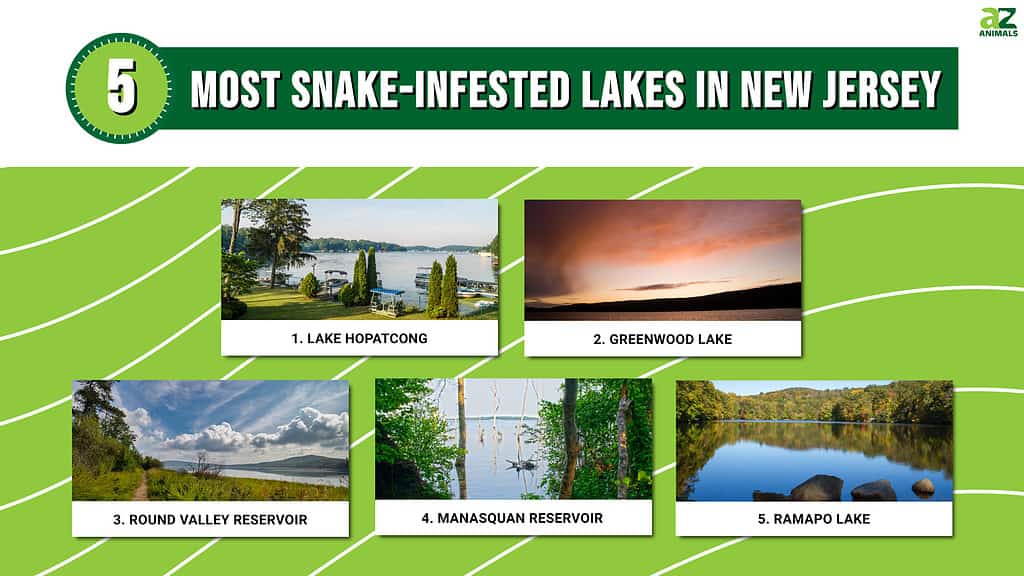
In this article, we will explore a collection of lakes in New Jersey known for their intriguing snake-inhabited waters. These lakes provide us with a valuable opportunity to further comprehend these captivating creatures! Just keep in the back of your mind that they may not be winning the award for the most snake-infested lakes that are found in New Jersey (or at least not in the way “snake-infested” might conjure up as an image in your mind).
If you’re considering swimming or boating in these lakes, it’s wise to be mindful of the potential presence of snakes. Should you encounter one, it’s advisable to maintain a safe distance and refrain from disturbing it. These are the following lakes to be reviewed:
It is important to note that while the majority of snakes in New Jersey are nonvenomous and harmless, the state is home to two venomous snakes: the timber rattlesnake and the northern copperhead.
1. Lake Hopatcong
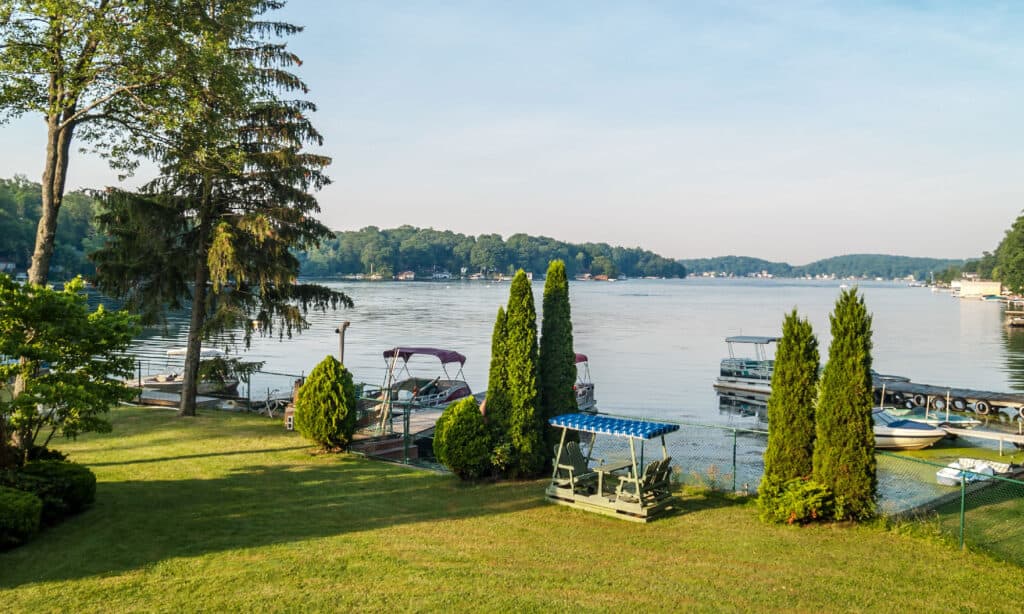
Lake Hopatcong is the largest freshwater body in New Jersey.
©iStock.com/andykazie
Lake Hopatcong is nestled in the lands region of New Jersey, a charming locale within the United States. Serving as a crown jewel, it proudly holds the title of the largest freshwater body in the entire state, spanning an impressive expanse of approximately 4 square miles. Lake Hopatcong came into existence by deliberately creating a dam and flooding two smaller ponds, known as the Great Pond and Little Pond. Additionally, the natural water outlet, the Musconetcong River, played a vital role in this process.
Lake Hopatcong offers a multitude of recreational activities, from swimming and boating to fishing and hiking. This scenic destination also hosts an array of charming restaurants and shops, attracting day-trippers and weekend adventurers alike. Immerse yourself in the beauty and serenity of Lake Hopatcong for an unforgettable experience. Just be sure to keep a lookout for snakes!
The snakes you’re likely to come across in and around Lake Hopatcong are generally harmless, like the eastern garter snake and the milksnake (just to mention a few). There is a small chance you could encounter a northern copperhead, which is a venomous snake. However, it is extremely unlikely, as copperheads are shy and elusive, and those in New Jersey are a “state species of special concern” due to their dwindling numbers.
2. Greenwood Lake

Greenwood Lake has been a very popular getaway for decades for many people, including celebrities like Cecil B. DeMille and Babe Ruth.
©Oralleff/Shutterstock.com
The Munsee Native Americans who lived at Greenwood Lake originally called it “Quampium”. Later, Europeans renamed it “Long Pond” when they settled in the area in the eighteenth century. Eventually, the lake came to be re-christened “Greenwood Lake.” The lake is a popular destination for swimming, boating, fishing, and other water sports. There are also a number of hiking trails and picnic areas around the lake as well.
Greenwood Lake holds significant importance in the Skylands region. Throughout history, it has served as a cherished resort community and a haven for celebrities from various fields such as Cecil B. DeMille, Babe Ruth, the Jeter family, and many others in sports and the arts. Even today, Greenwood Lake continues to offer abundant adventure, enjoyment, and tranquility for both families and individuals seeking respite.
However, be aware that Greenwood Lake is also home to a wide variety of wildlife, including many species of snakes. Snakes that you might encounter at Greenwood Lake include northern black racers, ringneck snakes, milksnakes, and water snakes. There is a very unlikely chance you’ll spot a copperhead or a timber rattlesnake, but they do live in this region of New Jersey. However, timber rattlesnakes do not typically live near lakes, preferring rocky or forested habitats. In addition, both timber rattlesnakes and copperheads are shy and elusive, and do their best to stay far away from humans.
3. Round Valley Reservoir
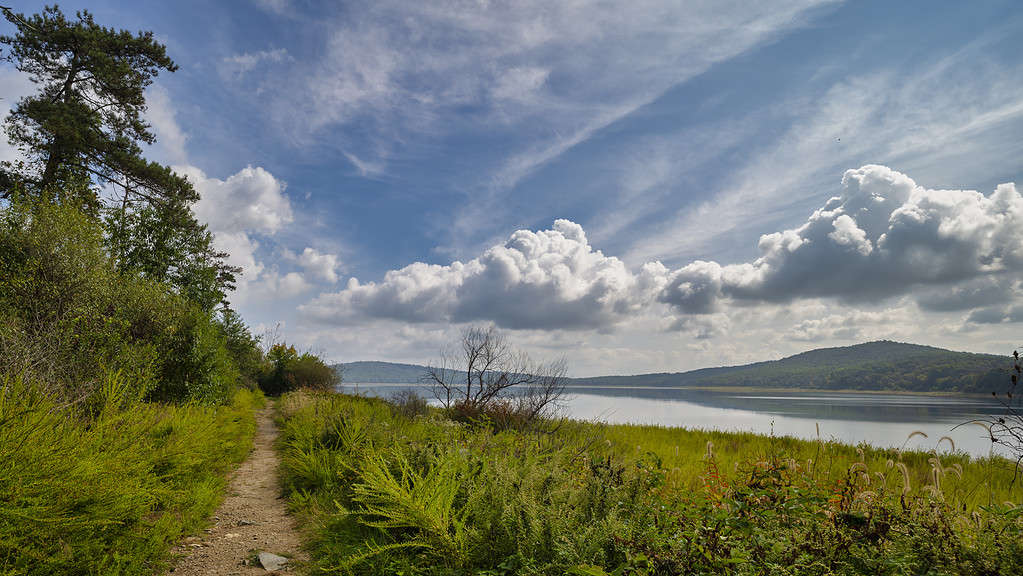
Round Valley Reservoir is teeming with a wide variety of wildlife.
©iStock.com/Thomas Kloc
Round Valley Reservoir, located in the Clinton Township of Hunterdon County, came into existence in 1960. The New Jersey Water Supply Authority constructed two significant dams, submerging an expansive valley surrounded by the majestic Cushetunk Mountain. The reservoir derives its name from the captivating circular shape of the valley, formed naturally over time.
With depths plunging down to 180 feet, this expansive 2,350-acre reservoir stands out for its remarkably clear azure waters. Notably, it has a staggering 55 billion US gallons of water, catering to the needs of central New Jersey and earning the title of the largest reservoir in the state. The reservoir attracts visitors with its abundance of recreational activities, including swimming, boating, fishing, hiking, and picnicking. Additionally, the area hosts picturesque trails and roads that provide scenic views of (and around) the stunning reservoir.
A fun fact about Round Valley Reservoir is that according to the New Jersey Division of Wildlife, the reservoir is the southernmost body of water where lake trout naturally reproduce. This beautiful place teems with a diverse array of wildlife, from graceful deer to quacking ducks, honking geese, and tranquil turtles, as well as snakes. Round Valley Reservoir is home to snakes like the northern water snake, black racer, and milksnake. Although black racers and milksnakes may look dangerous, they are completely harmless. But while northern water snakes are not venomous, they can bite pretty hard!
4. Manasquan Reservoir
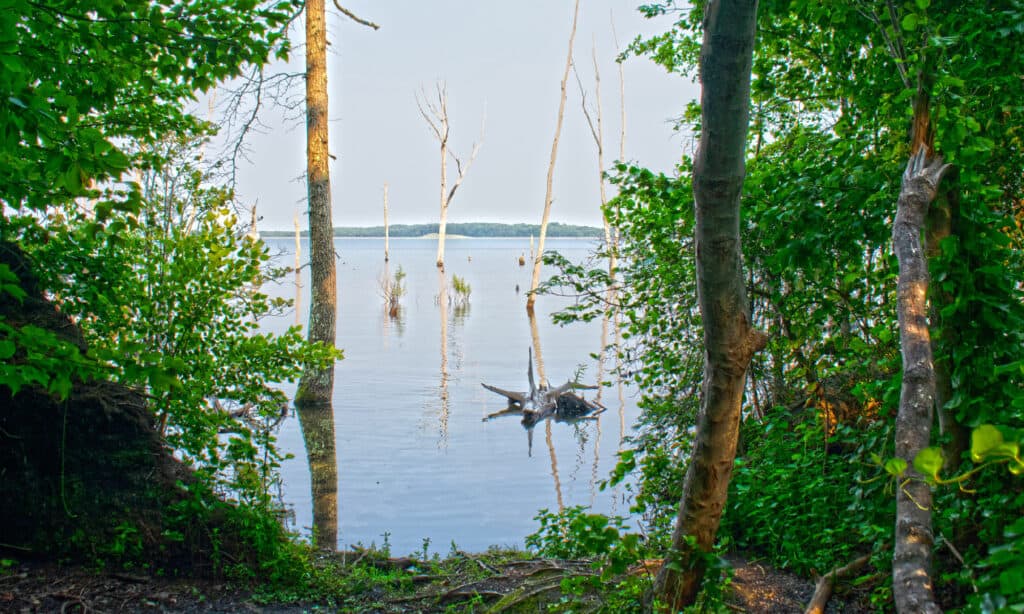
Manasquan Reservoir and its surrounding landscape are popular destinations for bird watchers, hikers, and wildlife lovers.
©iStock.com/Demetri2K
Manasquan Reservoir, nestled in the picturesque Monmouth County, is a magnificent freshwater haven that beckons nature enthusiasts and leisure seekers alike. Spanning an expansive surface area of 1,430 acres, it proudly holds the title of being the largest lake in Monmouth County. Operated by the New Jersey Water Supply, Manasquan Reservoir is a dammed reservoir from the Manasquan River.
Manasquan Reservoir offers lots of outdoor activities to enjoy, such as boating, fishing, swimming, and kayaking. The lake and park receive more than one million visitors each year. The land surrounding the Manasquan Reservoir is considered one of the best locations for hiking in New Jersey. There are five trails around the lake to explore, as well as an officially designated wildlife reserve.
The environment in and around Manasquan Reservoir is filled with wildlife, and the wildlife reserve protects numerous native species. The reservoir supports a thriving bird population, including majestic bald eagles that have made their nesting grounds on the north side of the lake. It is also home to many different species of snakes, like the eastern milk snake, northern copperhead, northern ringneck snake, northern black racer, and northern water snake.
5. Ramapo Lake
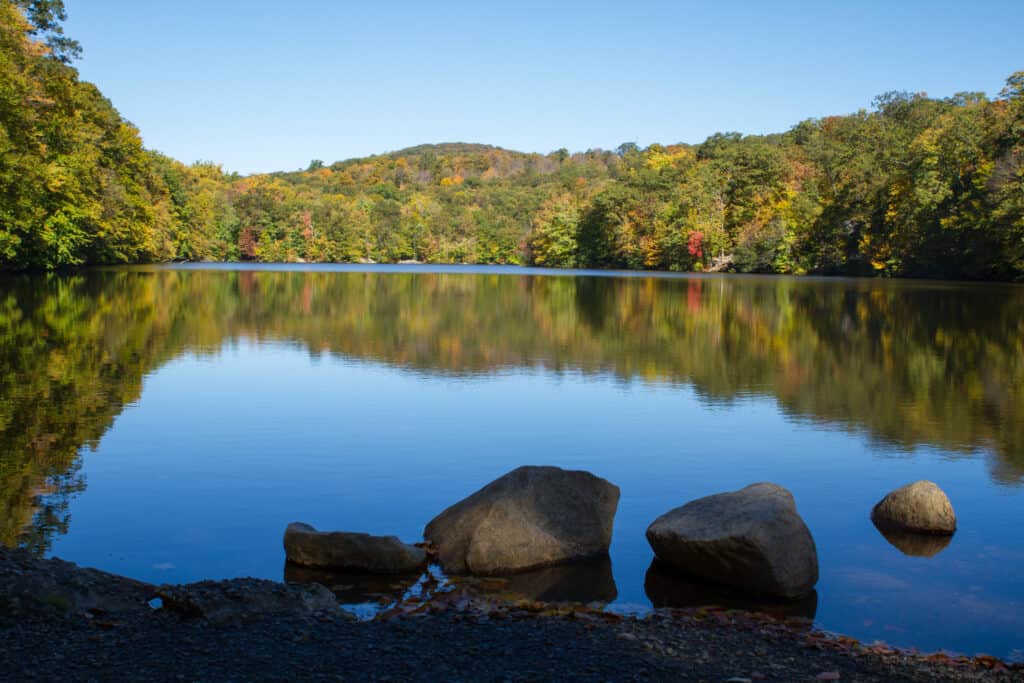
Ramapo Lake is in the Ramapo Mountain State Forest.
©iStock.com/klags
Ramapo Lake sits in the picturesque Ramapo Mountain State Forest in northern New Jersey. It is a man-made lake and spans an impressive 120 acres. Its origins can be traced back to the Dutch settlers who initially referred to it as “Rotten Poel,” meaning “Rats Pond.” The lake began as a small pond, but over time, a sturdy stone dam was added, making the lake deeper and larger than before.
Ramapo Lake is a popular place for birdwatching, hiking, and fishing. However, you cannot swim at this lake. There are many hiking trails though, with stunning views of the lake and surrounding landscape and Ramapo Lake Natural Area. This sprawling 1,400-acre expanse encompasses not only the lake but also the lush forest around it.
If you are planning to spend some time at Ramapo Lake, be sure to prepare for and respect its resident snakes. There are northern copperhead snakes living near Ramapo Lake, so be sure to watch your step and tread carefully. In addition, northern water snakes are commonly spotted in and around the lake, along with many other types of nonvenomous snakes.
Avoiding Snake Bites in New Jersey’s Most Snake-Infested Lakes
New Jersey is home to two venomous snakes: the timber rattlesnake and the northern copperhead. While these snakes are not commonly encountered, it is crucial to remain aware of their presence when venturing outdoors. Stay informed and vigilant during your outdoor adventures to ensure a safe and enjoyable experience. Here are a few tips to help you out with some snake bite prevention:
- When hiking or camping, wear boots, and long pants as a precautionary measure. This provides added protection for your legs against snake bites.
- Exercise caution in your environment, attentively scanning for the presence of snakes before taking a seat or stepping onto unfamiliar objects.
- Refrain from handling snakes, regardless of their venomous nature. It is always in your best interest to maintain distance and leave them undisturbed, even if you believe they pose no threat.
Venomous Snakes Living Around the Most Snake-Infested Lakes in New Jersey
Northern Copperhead
The northern copperhead snake (Agkistrodon contortrix mokasen) is a large venomous snake that lives in terrestrial and semi-aquatic habitats. that means that copperheads live both on the ground and in or near bodies of water like ponds, rivers, swamps, etc. copperhead snakes have copper-colored bodies with darker reddish-brown markings and distinct triangular-shaped heads. young copperhead snakes have bright yellow tail tips as well. although they are venomous and dangerous, copperhead snakes are shy and elusive, and usually only bite when they are stepped on, or if someone tries to handle them. Northern copperhead snakes in New Jersey only live in the northwest corner of the state.

Northern copperhead snakes are one of North America’s most common venomous snakes. Their incredible camouflage makes them seem almost invisible on the forest floor.
©JacobLoyacano/Shutterstock.com
Timber Rattlesnake
The only other venomous snake in New Jersey is the timber rattlesnake (Crotalus horridus). These large-bodied snakes are usually gray or light brown and have dark brown or black crossbands patterning their bodies. You will likely never see a timber rattlesnake near one of New Jersey’s most snake-infested lakes, as they prefer to live in the mountainous areas of Northern New Jersey, and habitats with fields, woodlands, and Rocky outcroppings. In addition, timber rattlesnakes are extremely shy and non-aggressive. However, you should still stay clear of timber rattlesnakes as they have a highly toxic venom that is fatal if not treated.
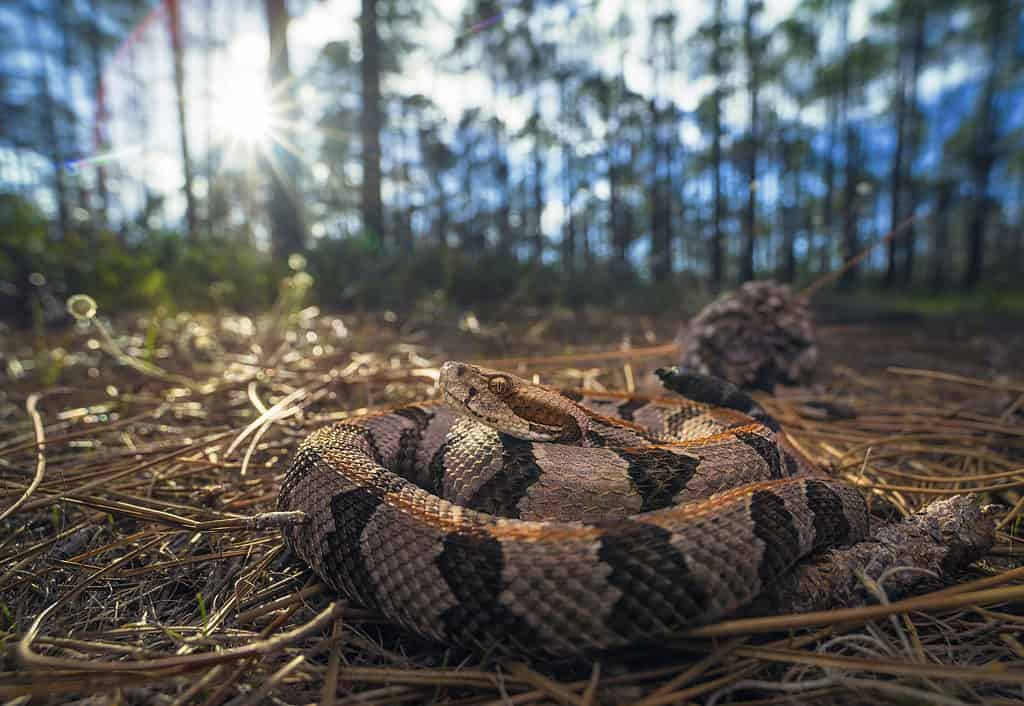
Timber rattlesnakes are rare in the eastern United States. They are also protected in these areas, so it is illegal to touch or harm them.
©Kristian Bell/Shutterstock.com
Other Snakes Living Around the Most Snake-Infested Lakes in New Jersey
Milk Snake
There are two different species of milk snake in New Jersey: the coastal plain milk snake (Lampropeltis triangulum) and the eastern milk snake (Lampropeltis triangulum triangulum). Milksnakes look a lot like venomous coral snakes. However, milksnakes are nonvenomous, gentle, and completely harmless to humans.
Milksnakes typically have a length ranging from 24 to 52 inches, with females typically slightly larger than males. Their color features a base of cream, gray, or tan, adorned with rows of reddish-brown blotches neatly edged with black. Additionally, certain individuals may exhibit a captivating Y- or V-shaped light patch positioned on the nape of their neck.
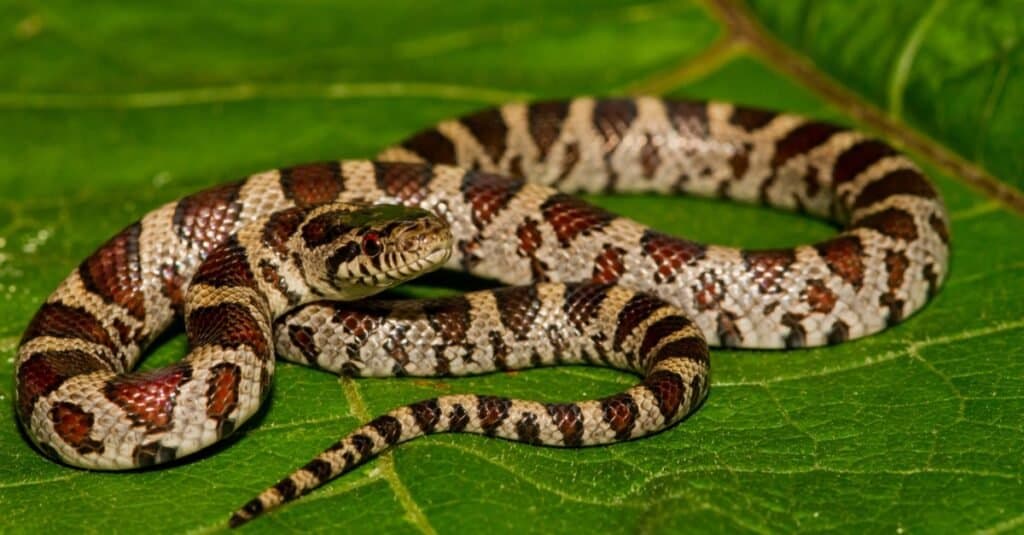
Eastern milk snakes are very beneficial animals, especially for farmers, as they hunt down small rodents often found on farm buildings and barns.
©Jay Ondreicka/Shutterstock.com
Northern Watersnake
The northern watersnake (Nerodia sipedon sipedon) is a nonvenomous snake that can grow up to 48 inches in length. Typically, these snakes inhabit areas near water and boast a body coloration that ranges from gray to brown, accentuated with noticeable dark brown or black blotches. They have thick bodies and are often mistaken for copperheads and timber rattlesnakes. Northern watersnakes do not have venom, but they can bite and are easily agitated.
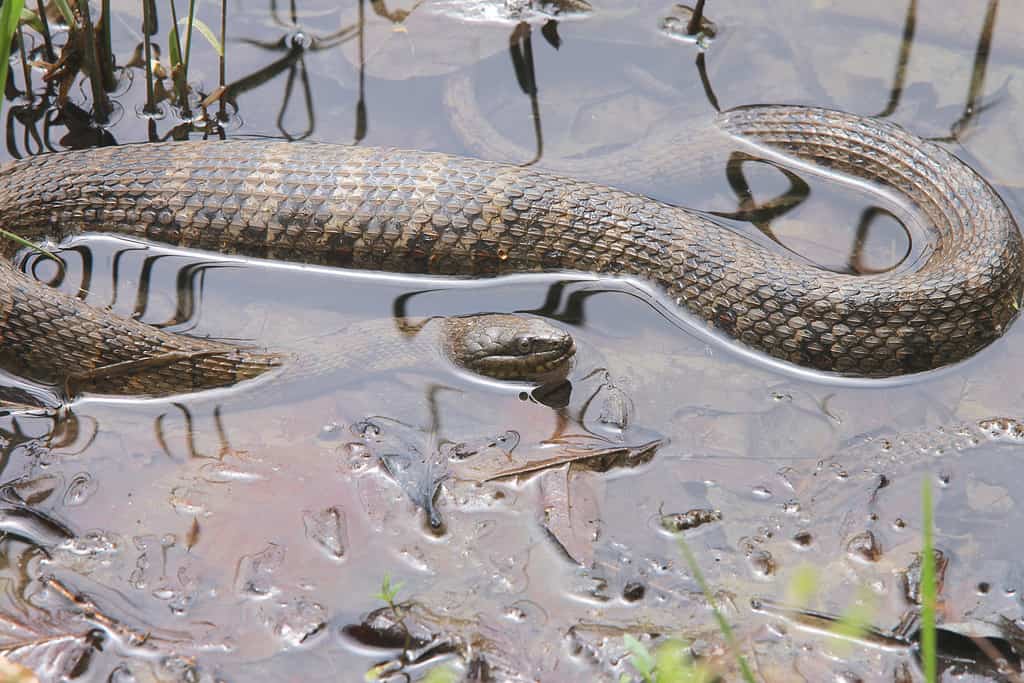
Northern water snakes are also known as common water snakes.
©iStock.com/NajaShots
Eastern Garter Snake
The eastern garter snake (Thamnophis sirtalis) is a harmless snake in New Jersey and throughout the eastern United States. It usually measures between 18 to 26 inches in length, with females slightly surpassing males’ size. Eastern garter snakes have varying colors, although most individuals exhibit a yellow or greenish stripe running along the center of their back, accompanied by two narrower stripes adorning the sides.

Garter snakes are some of the most cold-tolerant snakes in the world and are usually active early and later in the year than other species.
©Erik Agar/Shutterstock.com
Black Rat Snake
The black rat snake (Elaphe obsoleta obsoleta) proudly claims the title of the largest snake species ever found in New Jersey. This harmless serpent can grow up to an impressive length of 72 inches! Often spotted in barns and similar structures, these serpents flaunt a sleek black body with a contrasting underside in white or cream. Black rat snakes inhabit a wide array of habitats, ranging from woodlands and fields to suburban areas. These remarkable creatures remain active throughout the day and night.
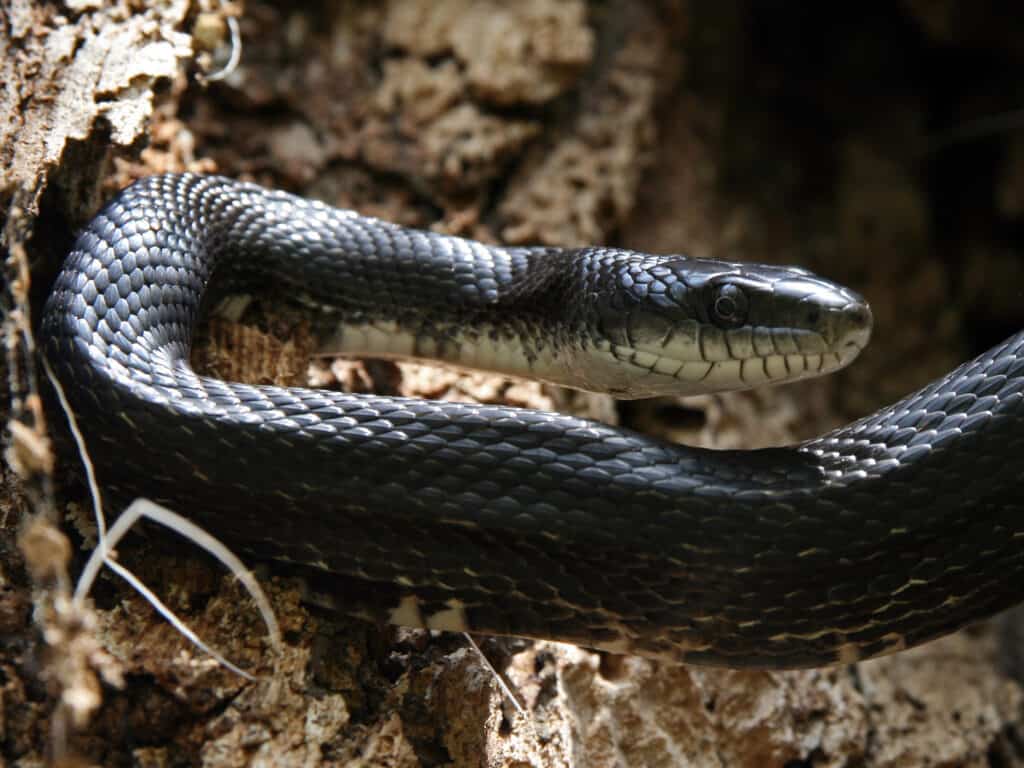
Black rat snakes display a diverse palate that includes rodents, birds, and lizards in their diet.
©Ryan M. Bolton/Shutterstock.com
Corn Snake
The corn snake (Pantherophis guttatus) is another animal that unfortunately gets confused for venomous and dangerous snakes, even though it is completely harmless. In fact, many people care for corn snakes as beloved pets because they are docile and have colorful bodies. Corn snakes typically grow 2 to 4 feet long with slender, smooth bodies. They are commonly red with black and yellow markings. Some are brightly colored, while others are darker or have duller shades. Corn snakes live in many different types of habitats, including meadows, forests, and fields. They are nocturnal and hunt small mammals, lizards, eggs, and birds at night.

Corn snakes are constrictors. Constricting snakes wrap their bodies to prey to squeeze and subdue it before swallowing it whole.
©Enrique Ramos/Shutterstock.com
Summary of the Most Snake-Infested Lakes in New Jersey
| Rank | Lakes | Snakes |
|---|---|---|
| 1 | Lake Hopatcong | Eastern garter snakes, milkshakes, copperheads |
| 2 | Greenwood Lake | Northern black racers, ringneck snakes, milksnakes, and water snakes |
| 3 | Round Valley Reservoir | Northern water snakes,black racers, milksnakes |
| 4 | Manasquan Reservoir | Eastern milksnakes, northern copperheads, northern ringneck snakes, northern black racers, and northern water snakes |
| 5 | Ramapo Lake | Northern water snakes, Northern copperheads |
The photo featured at the top of this post is © iStock.com/klags
Thank you for reading! Have some feedback for us? Contact the AZ Animals editorial team.







